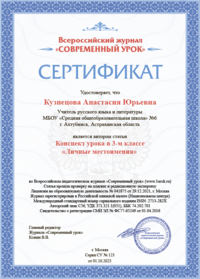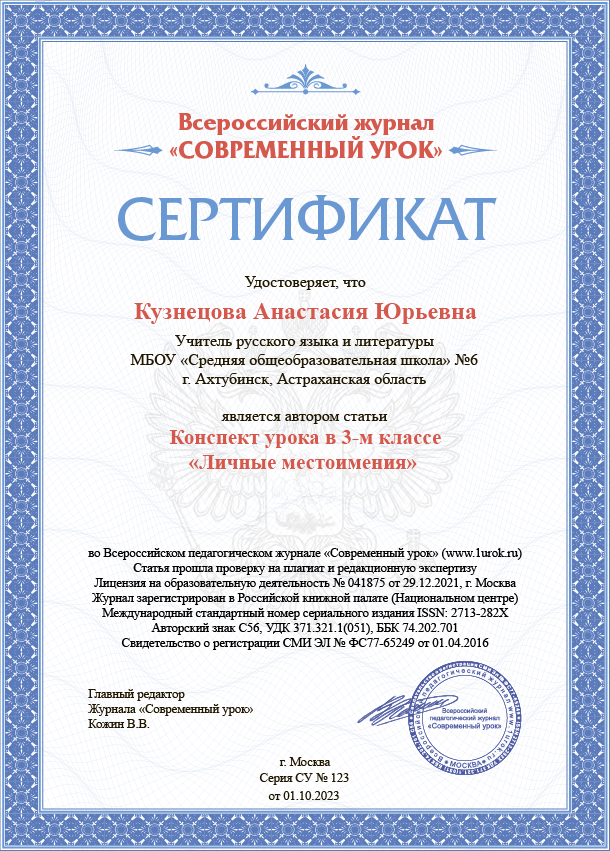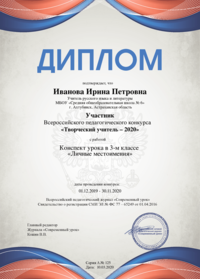План-конспект урока по английскому языку по теме «Family» на основе видео TED «How every child can thrive by five»
Автор: Капитонова Елена Петровна
Организация: МАОУ «СОШ «Аврора»
Населенный пункт: г. Саратов
Цель урока: Развитие коммуникативных умений и навыков у обучающихся по теме «Family».
Задачи урока:
Образовательный аспект – формировать и совершенствовать фонетические, лексические, грамматические навыки, навыки чтения, аудирования, устной речи.
Развивающий аспект – развивать мыслительные процессы, связанные с речевой деятельностью, учить логически излагать, сравнивать, анализировать.
Воспитательный аспект – воспитывать чувство гордости за свою семью, положительного, уважительного и толерантного отношения к окружающим, чувство любви и уважения к семье, к родителям, повышать интерес к этническим ценностям.
Тип урока: Урок открытия новых знаний.
УУД:
Личностные: создать нужный психологический микроклимат, развивать мысленное воспроизведение ситуации.
Регулятивные: уметь работать с незнакомым лексическим материалом, использовать языковые догадки при переводе новых слов, планировать алгоритм построения монолога, диалога и коммуникативных навыков. Владеть навыками самоанализа своей деятельности.
Познавательные: осознанно и произвольно строить речевое высказывание, обсуждать проблемные вопросы, высказывать предположения, импровизировать.
Коммуникативные: понимать возможность различных позиций других людей, уметь формулировать собственное мнение и позицию, аргументировать ее.
Формы работы: Фронтальная, индивидуальная, групповая и парная формы работы.
Оборудование: Интерактивная доска, демонстрационный текстовый материал, карточки с заданиями, картинки – настроения, цветы для составления букета настроения.
Межпредметные связи: связь с предметом «обществознание».
Ход урока:
I Организационная часть:
Приветствие:
T: Good afternoon, dear pupils!
Ps: Good afternoon, teacher!
T: Sit down, please! How are you today? What is the weather today?
Ps: The weather is not sunny today.
Введение в иноязычную атмосферу:
T: Now I want to show you the TED video segment. Have you ever heard about the Ted format videos? What videos have you seen?
Ps: Yes/No.
T: The name TED is derived from the first letters of the words Technology, Entertainment and Design. These are lectures by famous and smart people on different topics: science, art, business, design, culture and others. The lectures last between 11 and 18 minutes, no longer. The speaker should hold the audience's attention until the last minute. All of TED's activities are aimed at one goal: spreading great ideas.
Побуждение к определению темы и целей урока:
T: I want to show you the TED video “How every child can thrive by five”. (На экране название) How do you think what this name means. What is this video about? Who is the speaker? How old is he or she? Whom is this video for? (Ответы учащихся) I like your answers. Now, watch, please. (фрагмент видео 2 мин 11 сек).
T: What or who do you see? What are their names? How do they feel? What game did the girl mention? Why are some children unhappy? What can be the cause of it? Try to guess what we will talk about today.
Ps: E.g. These are children and an adult on the stage. She said about… May be we will talk about children or family relations.
T: Right you are! Today we will discuss something special and interesting for you. So, the name of the topic: Family. Everyone who has a happy family background can consider themselves to be in luck. To have loving and caring parents, brothers and sisters are really important.
What do we usually do at our lessons if we want to get more information?
Ps: We read, discuss, listen to the text, learn new words.
T: These are the main aims of our lesson.
II Основная часть урока:
T: So, I want you to watch this part of video again. (фрагмент видео до 2:11)
T: Now we will divide into three groups and I’ll give you cards with the task. (Учащиеся делятся на 3 группы. Учитель раздает карточки с заданиями для каждой группы) (Приложение 1) You have ten minutes to do this task. After that we’ll check your answers.
In ten minutes children present their answers and teacher check which is right or not.
T: We continue watching the video. Please, look at the screen. (фрагмент видео до 4:30). Now do the task. You have 6 ABCD questions with only one correct answer. (Приложение 2)
T: Now watch the rest of the video.
T: So, we see that family plays a great role in our life. The love and care of parents are especially important for children under 5. Such feeling as respect, understanding, support, loyalty, closeness should be in every family. On the screen you see the matching exercise word-definition. Can you match them? https://wordwall.net/resource/62954395 (Приложение 3)
III Заключительная часть урока:
T: So, what does family mean to you? How do you get on well with your family members? What is important in your family? What games did you play with your parents? Did you play the game of peekaboo with your younger brothers or sisters?
T: We come to the end of the lesson. Today we have spoken much about families; the family plays an important role in our life. You worked very well at the lesson and get good marks. Thank you for your work.
Рефлексия:
T: Now tell me, please. Did you like our lesson? I give you flowers. They are of different colours. Please, put them on the board and make the bunch.
(Приложение 1)
Card 1.
Put the sentences into the correct order according to the video segment. (Расставьте предложения по порядку соответственно увиденному фрагменту видео)
- My talk today is about some powerful things you grownups can do.
- Hi, I’m Molly and I’m seven.
- When Ari was born, he was tiny and he cried all the time.
- Oh, and this is my neighbor, Amarjot.
- That’s way more going on inside.
Card 2.
Mark the sentences as true or false(Обозначьте предложения как верные/неверные)
- The girl’s name is Kate Wright.
- The girl is seven years old.
- She thinks not all kids are so lucky as she is.
- The baby’s name is Ari and he is her neighbor’s son.
- The first five years are the most important for kids’ health and development.
Card 3.
Read the extract and choose the right word. (Прочитай отрывок и выбери верное слово)
Hi, I’m Molly/Kate and I’m seven/eight. And this is my little friend/brother, Ari. Say “Hi,” Ari. Hi. Oh, and this is my neighbour/uncle, Amarjot. He has to take Ari away now to get ready for our experiment. But don't worry, they'll be back. My talk today is about some powerful things you grownups can/can’t do. That shape us as children and the adults we become. How do I know? Because my parents and people around me did them early/late and often/never. I know not all kids are as lucky. Some of my friends, some kids at my school and many around the world. And I would really like/dislike to help change that. Thanks to scientists/mass media, we now know just how important the first five/seven years are for our health and development, especially our brains. Ari started learning long before he was even born, from inside his mommy’s tummy. When Ari was born, he was tiny and he cried/smiled all the time.
Correct Answers:
Card 1: 2, 3, 4, 1, 5
Card 2: F, T, T, T, T
Card 3: Molly, seven, friend, neighbor, can, early, often, like, scientists, five, cried
(Приложение 2)
Questions:
1. What happens to a baby's brain after the first year?
A. It decreases in volume.
B. It remains the same size.
C. It doubles in volume.
D. It becomes 90 percent the volume of an adult brain.
2. When do our brains develop the fastest?
A. During our early years.
B. During adolescence.
C. During adulthood.
D. Throughout our lives.
3. How many neural connections can our brains create every second?
A. Up to 100,000.
B. Up to 500,000.
C. Up to 1 million.
D. Up to 10 million.
4. According to the text, what are the top five things that contribute to healthy brain development?
A. Connecting, talking, playing, a healthy home, and community.
B. Eating nutritious food, exercising, sleeping well, reading books, and socializing.
C. Watching TV, using electronic devices, eating junk food, playing video games, and staying indoors.
D. Going to school, studying hard, participating in sports, having a strict routine, and following rules.
5. What is "serve and return"?
A. A game played with a ball.
B. A way of connecting, talking, and playing with children.
C. A strategy for building memory and trust.
D. A term used to describe the volume of an adult brain.
6. What do copycat games, naming games, and peekaboo have in common?
A. They all build imagination and empathy.
B. They all build vocabulary and attention.
C. They all build memory and trust.
D. They all involve playing with children.
Correct answers:
1. C
2. A
3. C
4. A
5. B
6. D
(Приложение 3)
|
Words |
Definitions |
|
1.Care |
a. providing assistance, encouragement, or help to someone in need. |
|
2.Support |
b. the ability to comprehend or grasp information or ideas. |
|
3.Respect |
c. the duty or task that you are expected to do or take care of. |
|
4.Understanding |
d. the act of looking after someone or something, ensuring their well-being and needs are met. |
|
5.Loyalty |
e. showing admiration, esteem, or consideration for someone's feelings, rights, or beliefs. |
|
6.Responsibility |
f. the quality of being faithful, committed, and dedicated to someone or something. |
|
7.Love |
g. a strong affection or deep emotional attachment towards someone or something. |
|
8.Closeness |
h. the state of being safe and protected from danger or harm. |
|
9.Security |
i. the feeling of being emotionally connected or intimate with someone. |
Correct matches:
1. d
2. a
3. e
4. b
5. f
6. c
7. g
8. i
9. h

 БЕСПЛАТНЫЕ семинары
БЕСПЛАТНЫЕ семинары





